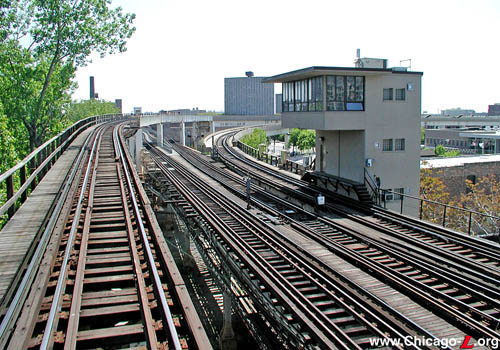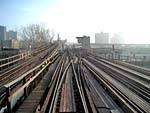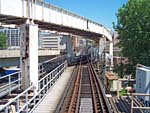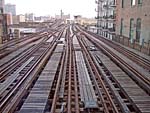|
|
|
|
 17th junction and tower, looking south on May 26, 2003. The tower dates from 1943 but the junction was built in 1969. For a larger view, click here. (Photo by Graham Garfield) |
|
|
|
|
 17th junction and tower, looking south on May 26, 2003. The tower dates from 1943 but the junction was built in 1969. For a larger view, click here. (Photo by Graham Garfield) |
17th
Junction
17th Street and State
Street, Near South Side
Service Notes:
Services:
Orange Line: Midway
Green Line: Ashland-East 63rd
Quick Facts:
Established: October 17, 1943 (tower), September 28, 1969 (junction)
Original Line: North-South Route, West-South Route
Rebuilt: 1993
Status: In Use
Profile:
17th Tower was placed in service in October 1943 to control the interlocking at the connection between the State Street Subway and the South Side Elevated.
After all North-South service was rerouted via the State Street Subway in 1949 there was little need for a staffed tower at 17th Street, since all trains to and from the South Side went into the subway rather than onto the Loop Elevated. North Shore Line interurban trains still used the old South Side Elevated between Tower 12 and Roosevelt Road, but not south of Roosevelt. Therefore, over time, coverage at 17th Tower was reduced. On July 3, 1955, attended operation of 17th Tower was reduced to morning and evening rush hours Monday through Friday only. A few weeks later, on July 25, 1955, all attended operation of 17th Tower was eliminated. The interlocking plant was left in service, though unstaffed, for nearly another decade. The interlocking at 17th Street was removed from service on April 28, 1964, with the switches were converted to hand-throw operation. Back then, the CTA had a history of reusing interlocking machines, rebuilding and moving them frequently, and the relays, racks, and other equipment from the plant was more than likely moved and reused at another location.
17th Tower gained a new use when the Dan Ryan Line was built in the late 1960s. The Dan Ryan Line connected to the South Side Elevated at 17th Street, creating a new junction south of the old tower. The junction was grade-separated, with a flyover for the northbound Dan Ryan track so that it would not have to foul north- or southbound North-South Route trains. The new junction was arranged so that West-South Route (Lake-Dan Ryan) trains stayed on the outside tracks to connect to the Loop Elevated while North-South Route trains stayed in the middle and descended down into the subway. Therefore, no switching actually had to take place during regularly-scheduled service and 17th Tower did not need to be staffed. Still, switches were installed to allow trains to switch tracks and 17th Tower was modified to control the new 17th Junction when necessary.
17th Tower gained new importance when the Orange Line was built. Connecting to the Loop via the old Dan Ryan connector track at 17th Junction, the new line meant that now trains to and from the Loop on the same track did have to be sorted southbound at the junction -- some would come to and from the South Side elevated, but others would come to and from Midway. Still, it was desirable not to have to staff the tower at all times, so an automated interlocking was devised. The Orange Line trains carried transponders, which emitted a radio signal identifying them. A transponder reader was located south of Roosevelt station and let 17th Junction know what type of southbound train is coming. If no transponder was detected, then the switches were set for the default routing, which was for the Green Line to 63rd. If a transponder was detected, the route was set for the Orange Line to Midway. No vehicle identification was necessary northbound, since inbound trains are merged at the junction rather than sorted; inbound Green and Orange line trains simply receive a route and clear signal on a first come, first served basis. If train operators receive an incorrect lineup at 17th Junction, wayside route selectors are available to allow the operator to cancel and enter the correct lineup. The 17th Junction interlocking plant was replaced during summer 1993 and placed in service on September 13, 1993.
17th Junction received some modest work while the Green Line was closed for rehabilitation in 1994-96, placed back in service on February 2, 1996.
The practice of equipping Orange Line-assigned trains with transponders continued for about 20 years. It was a somewhat cumbersome practice, because only cars assigned to the Orange Line were equipped with them, which meant anytime assigned cars were transferred to or from Orange Line service, the transponder had to be installed or removed, or the cars would not register with the wayside detector and the incorrect default (Green Line) route would be set at the junction.
This changed after the Green Line was fully equipped with 5000-series railcars. The 5000s are all equipped with AVI (Automatic Vehicle Identification) tags; these were included on the all the cars of that series as part of their base equipment as built and delivered by the manufacturer. Further, rather than only transmitting one hard-coded identification, the tags are integrated with the railcar's systems, so the train transmits what route and destination it is based on the terminal/destination entered by the train operator on the car's Train Operator's Touch Screen (TOTS) interface in the motorcab at the beginning of the trip (the same input sets the train's destination signs, marker lights, and pre-recorded announcement sequence). Therefore, currently the wayside receiver for 17th detects the presence of a Green Line train (if it is made of up 5000-series railcars) and sets the switches for the Green Line if a train transmitting a Green Line route is detected. If no AVI tag is detected, 17th Interlocking is set southbound for the Orange Line route, the current default. Orange Line trains no longer carry transponders.
 |
17thJct02.jpg
(182k) |
 |
17thJct03.jpg
(239k) |
 |
ROW@17th01.jpg
(229k) |
|
|